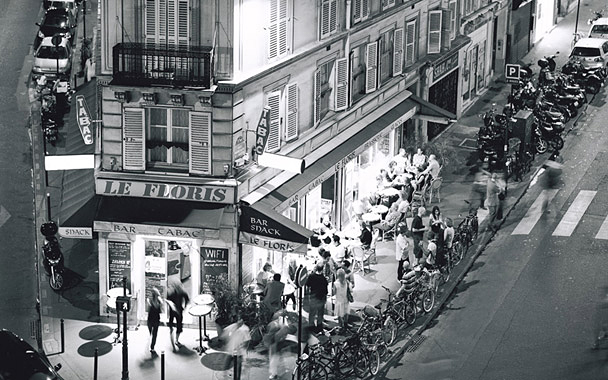Wandering around Paris in the ’60s, I’d sit in the parks eating bread and cheese, pretending that at any minute I’d turn the corner and bump into F. Scott Fitzgerald. I’d walk down the Rue Mouffetard to buy cheese at Androuët, yearning up at the house where Hemingway once lived. I haunted Shakespeare & Company, as if by staying long enough I might make Joyce or Stein actually appear. It was a magical place, and I went back again and again on cheap charter fares, wishing I could afford to live there the way the writers of the ’20s had. But everything was so expensive! By staying in cheap pensions and eating dinner in working-class cafés, I managed to get by on $3 a day. Still, as I sat munching Brie in the Luxembourg Gardens, I always wished I had been born earlier.
It never occurred to me that one day I would look back on Paris in the ’60s as its own magical time, an affordable feast of art and culture where you woke up every morning convinced that an eating adventure was waiting for you.
But those days are long gone. In the Paris of modern luxury, with its three-star restaurants and five-star hotels, a person could spend $5,000 a day without even trying. It is a lovely place, but not exactly filled with surprises. Lately I’ve been wondering if, beneath all the glitter, the Paris of my past was still there.
And so I set off to find it. For one rainy spring week, travel editor Bill Sertl and I stayed in cheap hotels, wandered the streets, rode the métro, and attended free cultural events. Above all, we ate. What we discovered is that you can live stunningly well in Paris for very little money. Young chefs all over the city are serving thrillingly innovative food at remarkably affordable prices. And even with the dollar so low, if you are very careful (and, as you’ll see, very lucky), you can stay in charming hotels that allow you to participate in the life of the city. I left luxury behind, but I have never eaten better or had as much fun doing it. Thanks to the new young chefs, Paris is reclaiming its title as food capital of the world, and I’m pretty sure that 30 years from now we’ll all be looking back at this time with enormous nostalgia.
The Eurostar travels from London to Paris in two hours and fifteen minutes, and I fretted about the hotel for the entire trip; what could I realistically expect for 80 euros? For the first couple of nights, I’d chosen a modest place at the very edge of the 5th arrondissement because of its proximity to the Rue Mouffetard. The bed might be lumpy, but I wouldn’t go hungry.
Hôtel de L’Espérance turned out to be short on charm—the television in the lobby blared constantly—but the room was clean, comfortable, and larger than I had imagined. It had a desk, a TV, even an air conditioner. Dropping my bags, I headed out to eat, sniffing in at Androuët, the great cheese store, marveling at the size of the fat white asparagus, as big around as salamis, in the Mouffetard markets. By dinnertime, I was starving.
I was even hungrier by the time we reached Hier et Aujourd’hui, a serious hike from the nearest métro station. Happily, we had no sooner taken our seats than the waitress plunked a heavy terrine of pâté onto the table, along with a jar of crisp, home-cured cornichons and a basket of bread. “While you consider the menu,” she murmured.
There was a lot to consider. The 28-euro menu is large, and it changes constantly, but every single thing we tried was superb. Franck Dervin has worked with both Alain Dutournier and Guy Savoy, but his cooking is very much his own. His pot de crème de foie gras topped with a Port reduction was so extraordinarily seductive that we could tell who was eating it simply by listening for the moans. His tartare of beets looked like an adorable little bouquet topped with tiny leaves of spinach and infant anchovies. Its taste was equally attractive; with each bite, the layered sweet and salty flavors did enthusiastic somersaults in my mouth.
Parmentier of pig’s foot is never pretty, but this deconstructed porcine hoof with its little hat of puréed potato was all texture and richness, and we wasted no time staring at it; in a flash, it was gone. So was a “risotto” of lentils topped with lobster.
We finished with a classic baba drenched in rum and a clean, fresh carpaccio of pineapple dotted with raspberries. With a bottle of 20-euro Côtes du Rhône, the meal was 76 euros for two, including tax and tip. “If this is what eating on a budget is all about,” I said to Bill, “this is going to be a great week.”
Under ordinary circumstances, we would not have even noticed Christophe. But the sign in the window offering a 12-euro lunch was irresistible; we walked right in. I immediately liked the modest little restaurant because the waitress was so sympathetic. When we said we’d be skipping wine in favor of a free carafe of water, she smiled and said, “You’re right, it’s too early for wine.” And her pride in the chef, Christophe Philippe, was infectious. “Taste the compote of tomatoes on the side,” she insisted as she set down plates of accras de poisson, airy little fish fritters. “It is homemade. Even the balsamic vinegar is fait maison!”




 Pinterest
Pinterest


